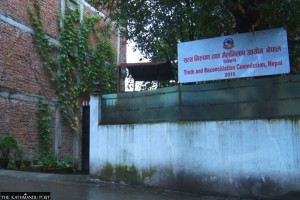Opinion
Death of a teacher
The semester system at Tribhuvan University helps students claim agency over their writing and knowledge
Shuv Raj Rana Bhat
A semester classroom at the Central Department of English, Tribhuvan University in Kirtipur is a sight to behold. Unlike rows of desks and benches perennially fixed to cemented floors, you have six pairs of desks and benches in a U-shape, which allows face-to-face conversations among students without obscuring their views of the whiteboard. Another row of desks in an L-shape surrounds the U-shape desks from two sides. Two white lightbulbs and a few red and green wires dangle from the ceiling and electric fans buzz on the walls making the students’ hair whirl in the air.
Group performance
At the back left corner, there stands a teacher leaning her shoulder against the wall. Dressed in a green sari, she is a middle-aged woman, with brown, dull hair, very elaborately arranged. Like a spectator at a stadium, she watches her students perform their roles. Her students, in their casual clothes, are busy doing class activities. On the front wall hangs a spotlessly clean whiteboard with a few blue-inked words which read, ‘Writing with Style’. At the far end of the room, a teacher’s lectern leans against the wall, with its short front legs suspending just above the floor.
With no podium and, by extension, no teacher at the centre of the class, your eyes are arrested by students caught up in the excitement of working in groups. You see 37 students in their respective groups—girls and boys—all immersed in the act of reading ‘writing with style’, a chapter from their course on academic writing. After a while, they begin to share what they have learnt from the text. Any confusion invites discussion, which is often followed by a hot debate that only gets settled after considerable dialogue. Finally, the group representative reports the outcome of their discussion. The group work culminates in the teacher’s comments, followed by a great round of applause.
Placing the podium
This scene triggers several interpretations and responses. First, I am drawn to the teacher’s podium which I consider a symbolic representation of the teacher herself. As an emblem of the teacher, it is associated with authority, control and epistemology. But now, the podium, which earlier held a dominant position in the class, is no longer the locus of the class. The day the podium was sidelined from the centre of the class to the margin, the teacher began to experience her first and sudden pangs of uneasiness. With the marginalisation of the lectern, the teacher is literally and metaphorically decentred from the frontal position of the class and her role as the controller of and disseminator of knowledge.
The replacement of the podium with a table equal to the height of the desks suggests the breakdown of an asymmetrical relationship between students and teachers. It is the end of the traditional concept of a teacher as the centre of class and the beginning of an egalitarian teacher who prefers to hold a dialogue with students instead of a monologue.
The way students burst to have their say in the group work posits that they are no longer passive recipients of information. They are active participants seeking a conducive learning atmosphere for themselves. With no teacher supplying information and controlling their work, they are involved in the meaning-making process. It shows their desire to speak, locate themselves in the class and become subjects in the construction of their identities. They want to be heard, recognised and visible in the academic world.
Through active participation in writing and critical thinking, students claim agency over their own writing and knowledge while situating their voices in a dialogue with the voices of others in their class. Academic writing, because it is inhabited by the people, places and ideas of the writers’ past experiences, helps situate the students within their contextual communities. They can interact with the people around them and learn to recognise and analyse the different ways of knowing and acting in which others are engaged.
Sense of agency
With students overpowering her in the class, the teacher realises that her role as a stern lecturer, an authority and giver of knowledge has dwindled. She experiences a sense of impending doom but she is not at all terrified of the death because this is not a horrendous death, one that would annihilate the egalitarian and inspiring teacher in her. Instead, she is elated at the decimation of herself; she is actually celebrating her death because it is that death which illuminates many lives, a death that breathes the fresh air of knowledge, wisdom and independence into students until posterity.
She pines for a moment when her students will leave her with a greatly enlarged sense of their own agency and their responsibility as scholars and rhetoricians. She says, “When a teacher dies, students are born,” reminding us of the proverb—a teach-er is a candle that consumes itself to light others. She further states, “When the old teacher in me—a teacher who subdues students’ voice in the class, believes in a monolithic method of learning, loves to only transmit information and controls students’ experiential learning—dies, a new teacher—who inspires through the creation of a congenial atmosphere for students to learn for themselves, treats students on equal footing and listens to and respects students’ voice—is born.”
Rana Bhat is a lecturer at the Central Department of English, Kirtipur ([email protected])




 24.18°C Kathmandu
24.18°C Kathmandu










